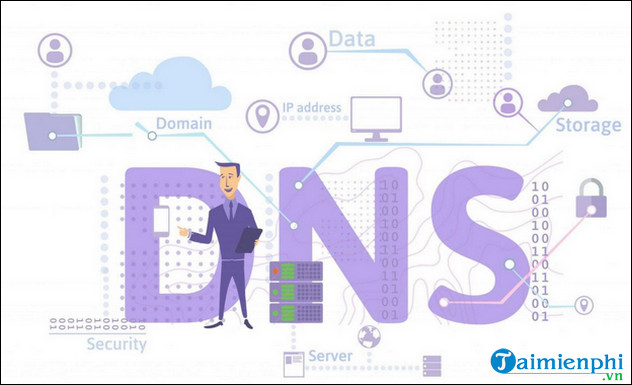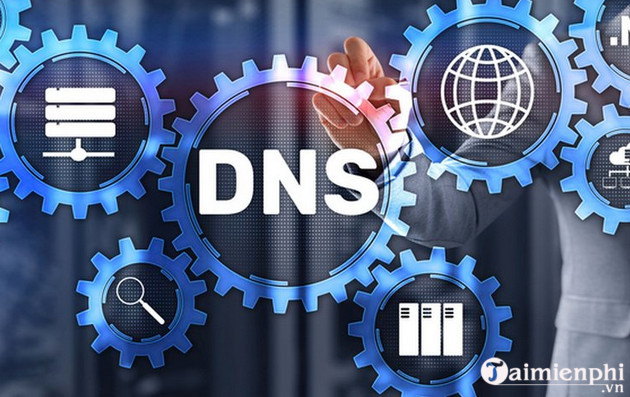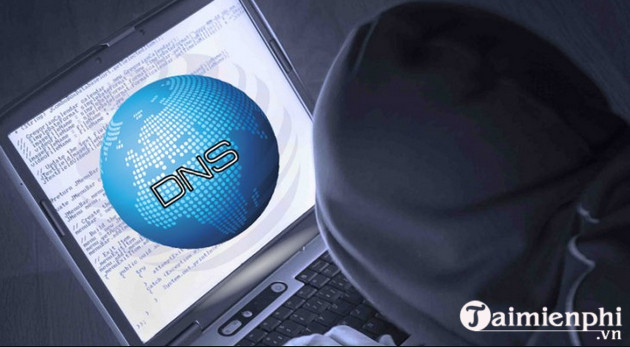What is DNS, basic knowledge about DNS
DNS is a computer network protocol. The basic job of DNS is to 'turn' a user-friendly domain name, such as " howstuffworks.com " into an IP address, such as 70.42.251.42 that computers use to identify each other on the Internet. network. DNS can be compared to a computer's GPS on the Internet.
1. Learn about DNS?
DNS, short for Domain Name System, is a domain name resolution system that allows establishing correspondence between IP addresses and domain names on the Internet.
Computers and other networked devices on the Internet use IP addresses to 'route' user requests to the website they are trying to access. To put it simply, it's similar to the way you dial a phone number to connect with the person you want to call and talk to.
Thanks to the useful use of DNS, users do not need to keep a list of their own IP addresses. Instead, simply connect through the fastest DNS, Domain Name System or Name Servers, managing a facility. Huge data maps domain names to IP addresses.
Whether you're visiting a website or sending an email, your computer uses a DNS server to look up the domain name you're trying to access. The 'best' term for this process is DNS name resolution, and it's not wrong to say that a DNS server resolves domain names to IP addresses.

For example, when you type http://www.howstuffworks.com into the address bar of any browser on your computer, part of the network connection includes resolving the domain name "howstuffworks.com" into an address. IP, such as 70.42.251.42 for HowStuffWorks' web server.
If you want to bypass DNS Lookup, just enter 70.42.251.42 directly into your browser. Additionally, a website's IP address can change at any time, and some websites associate multiple IP addresses with a single domain name.
Without a DNS server, the Internet will 'shut down' very quickly. Normally, when connecting to the Home Network, Internet service provider (ISP) or WiFi, modem or Router (router) assigns your computer's network address and sends some important network configuration information to your computer or mobile device. That profile includes one or more DNS servers that the device uses when translating DNS names into IP addresses.
At this point, you must have grasped some basic knowledge about DNS. To dig deeper, let's look at the IP address structure and how it matters to the domain name resolution process in the next section below.
2. DNS Servers and IP addresses
As mentioned above, the main task of a DNS (Domain Name Server) is to resolve (or in other words translate) a domain name into an IP address. This sounds simple but in reality it is not simple at all. The reason is because:
- There are billions of IP addresses in use.
- DNS servers are processing 'billions' of requests on the Internet at any given time.
- Every day millions of people are adding and changing domain names and IP addresses.
To solve problems, DNS servers rely on network performance and Internet protocols. As for IP addresses, each computer on the Internet has a unique IP address (including IPV4 and IPV6 standards) managed by IANA (Internet Assigned Numbers Authority).
Here are some ways to identify IP addresses:
- 1 IPV4 address has 4 groups separated by dots, the sequence will be ABCD For example: 70.74.251.42
- 1 IPV6 address has 8 groups, each group of 16 bits is represented as a hexadecimal number (Hexa -Decimal) and separated by a colon. For example, 2001: 0cb8: 85a3: 0000: 0000: 8a2e: 0370: 7334.
However, IPV6 is a very new standard, so in this article Free Download will focus on the more popular IPV4 standard.
Each number in the IPV4 address group is called an 'Octet', each Octet has 8 bits, equivalent to 1 byte.

For example, Octet written as 42 stands for 00101010. Each digit in a binary number is a placeholder for a certain 2-digit number from 2 to 27, read from right to left. This means that in 00101010, you have a number 21, 23 and 25. So to get the base equivalent -10, just add 21 + 23 + 25 = 2 + 8 + 32 = 42.
Certain addresses and address ranges are designated by IANA as private IP addresses. For example, the IP address 127.0.0.1 is used exclusively to identify the computer you are using.
Where does a computer's IP address come from? If we're talking about a computer or laptop, the address probably comes from a DHCP (Dynamic Host Configuration Protocol) server on your network.
The DHCP server's main job is to make sure your computer has the IP address and some other network configuration it needs whenever you're online. Because this is a dynamic address, your computer's IP address may change.
Web servers and other computers need a consistent point of contact using static IP addresses. This means that the same IP address is always assigned to the network interface when online.

To ensure that the interface always receives an IP address, IP associates the address with the MAC (Media Access Control) address on the network interface. Each network interface, including wired and wireless networks, has a unique MAC address embedded by the manufacturer.
3. How to find IP address
Here are some ways to find out your computer's IP address. Note that IP addresses may change periodically unless you use a static IP address.
- Windows : The fastest way to find the IP address on a Windows computer is to open a Command Prompt window, then enter the ipconfig command there.
- Mac : Open System Preferences , then click Network and make sure your current network connection (with the blue dot next to it) is selected, then click Advanced then click the TCP/ tab IP .
- Linux or UNIX : Open a Terminal application, such as XTERM or iTerm, then enter the ifconfig command there.
- On smartphones using Wifi : Search for the IP address on the network setup page. Each phone model will have a different way to access and check network settings.

Surely you have heard the concept of changing DNS to access blocked websites, right? Changing DNS is quite simple, does not take up much of your time but helps access blocked websites.
Computer networks have many different concepts, and to become a good network administrator, you need to know all of those concepts, and the concept of ISP is one of them, if you don't know what ISP is? Please refer to Taimienphi's article about what an ISP is to supplement your knowledge.
DNS and NetBIOS are both important components in the user's computer. To see the advantages and disadvantages of these two concepts, you can follow the article on the difference between DNS and NetBIOS to expand further. your knowledge.
You should read it
- 5 reasons why you should invest in self-study
- How to print an Excel spreadsheet in a page
- Microsoft still supports Windows RT despite being 'turned away' by firms.
- How to add photos and videos to albums shared on iPhone, iPad
- 8 best optical cable modems and cables 2018
- 7 quick control tips for Windows 10
- How to speed up Internet connection with cFosSpeed
- 5 popular wireless projectors to connect to laptops, phones
May be interested
- Test basic understanding of computers
 in the age of technology 4.0 today, computers are a great tool for people in work and entertainment. you can sit next to the computer for hours to work. however, are you sure you master the basics of computers? let's try with the multiple choice questions below.
in the age of technology 4.0 today, computers are a great tool for people in work and entertainment. you can sit next to the computer for hours to work. however, are you sure you master the basics of computers? let's try with the multiple choice questions below. - CSS test with answer - Part 1
 in the quiz below, try your knowledge of css with interesting questions.
in the quiz below, try your knowledge of css with interesting questions. - Microsoft Excel Test P14
 excel is a spreadsheet program that is extremely useful for people who work as an office or a teacher. to help you gain more useful knowledge, in the following quiz network administrator has edited very interesting questions to help you expand your knowledge. let's try it together.
excel is a spreadsheet program that is extremely useful for people who work as an office or a teacher. to help you gain more useful knowledge, in the following quiz network administrator has edited very interesting questions to help you expand your knowledge. let's try it together. - Test information about Internet Explorer browser
 please read the knowledge of the internet with the following multiple choice questions of network administrator. with this question set, hope you will get more useful knowledge about this topic.
please read the knowledge of the internet with the following multiple choice questions of network administrator. with this question set, hope you will get more useful knowledge about this topic. - Understanding the OSI Model (Network Knowledge Part 17)
 the network model used by windows and most other network operating systems is called the osi model. the osi term is abbreviated by the open system interconnection basic reference english phrase.
the network model used by windows and most other network operating systems is called the osi model. the osi term is abbreviated by the open system interconnection basic reference english phrase. - Basic computer test - Part 5
 following the series of basic questions about basic informatics, the following article will continue to be multiple choice questions so you can try your own knowledge about this topic.
following the series of basic questions about basic informatics, the following article will continue to be multiple choice questions so you can try your own knowledge about this topic. - To learn about SQL and databases, do not ignore these 23 online resources
 if you intend to learn about sql and databases, you should not ignore these 23 online resources. these websites will provide you with basic and advanced knowledge of sql and databases.
if you intend to learn about sql and databases, you should not ignore these 23 online resources. these websites will provide you with basic and advanced knowledge of sql and databases. - TCP and IP options
 going back to the basics is always a good idea. one of the most basic parts of computer communication knowledge is four basic protocols: ip, tcp, udp and icmp.
going back to the basics is always a good idea. one of the most basic parts of computer communication knowledge is four basic protocols: ip, tcp, udp and icmp. - What is Zero-Knowledge Encryption? Why use this type of encryption?
 data breaches are becoming more and more common, so it's essential that you know about the different ways you can protect your valuable information. zero-knowledge encryption is one of the methods that provides superior privacy and data protection.
data breaches are becoming more and more common, so it's essential that you know about the different ways you can protect your valuable information. zero-knowledge encryption is one of the methods that provides superior privacy and data protection. - Interesting knowledge that you never expected
 interesting knowledge every day will tell you more special things about life. below are interesting knowledge that many people still do not know.
interesting knowledge every day will tell you more special things about life. below are interesting knowledge that many people still do not know.










 How to change DNS on Windows 11/10/8/7 and macOS to surf the web and speed up the network
How to change DNS on Windows 11/10/8/7 and macOS to surf the web and speed up the network How to change DNS on Windows 11, surf the web, watch movies faster
How to change DNS on Windows 11, surf the web, watch movies faster How to view WiFi password, view WIFI password on Windows 11
How to view WiFi password, view WIFI password on Windows 11 How to set a Windows 11 computer password, set a Windows 11 password
How to set a Windows 11 computer password, set a Windows 11 password How to create USB BOOT to install Windows 11 from standard ISO file using Rufus
How to create USB BOOT to install Windows 11 from standard ISO file using Rufus How to turn off Update Win 11 permanently, block the latest update 2024
How to turn off Update Win 11 permanently, block the latest update 2024